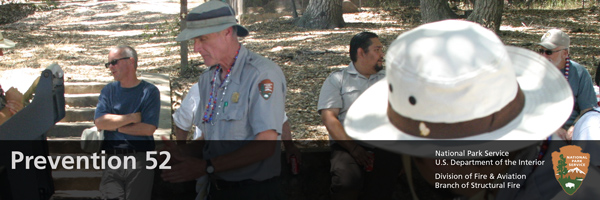
When was the last time that the local fire department (or your park's own engine company) toured your visitor center, historic structure, or museum storage facility? If it has been more than a year, it's time to have the department over for another visit. NPS policy mandates that every park advise local fire personnel "of the locations and characteristics of cultural resources that could be threatened by fire and of any priorities for protecting them." The best way to carry out this important requirement is to invite your local emergency responders over for a visit. Get together for a meal while you're at it. See if the top chef on your staff will help you with the barbeque--your emergency responders deserve the best!
While on-site, have them assess the safety of your facility, make suggestions for any needed improvements, learn (or refresh their memory) about the building's layout, complete or update their pre-incident plan, and note any hazards or special considerations. This way, both firefighters and park staff can be better prepared and save critical minutes in the event of an emergency. Give the department the full "behind the scenes" tour. Point out your highest priority items and have a conversation about how best to protect them during a fire. As an example, don't forget to show the baskets in John Muir's study; note their importance, then ask that responders not spray water in that direction if at all possible.
Ask if the department has any suggestions to make it easier for responders to access or move around the structure in an emergency. Perhaps an end table should be moved another foot away from the door, so the firefighters don't hit the table as they quickly enter the building with their full load of equipment. Be sure to point out the locations of all hazardous materials, such as where you store natural history specimens preserved in alcohol. All of this information will assist the department in creating a pre-incident plan for your building(s). When you invite the fire department to the park, ask about the possibility of conducting fire extinguisher training for park staff while they are on-site.
Once you've shown the firefighters all your facilities, it's time to eat. Make it an all-employee potluck barbeque. That way the entire park staff can meet their local fire department, become better acquainted, and everyone enjoys a good meal.
Fire Info for You
Employees
Ask questions when the firefighters visit; don't be shy when you can learn from the experts. Show the firefighters everything--don't be embarrassed by areas you know need improvement. It's vital that the firefighters see everything, that way they can address all potential issues. Involve the building and utilities management staff, PSFC, chief of cultural resources, superintendent, and chief ranger in the entire process from planning to inspection to facility tour.
Firefighters
Ask questions during the tour and please make any suggestions needed for improved fire safety.
Park Structural Fire Coordinators
Participate in the tour and the cookout. Be involved in all discussions with park and fire staff.
Park Leadership
The involvement of park management is critical for success, as it demonstrates the importance of fire safety at the park. Attend the tour with the park staff and the fire department. And of course don't miss the cookout. Fire safety at the park is paramount--from the superintendent to the first-time seasonal employee--and everyone else in between!
Take Action
- Make sure that all rooms and cabinets housing hazardous materials, such as natural history specimens in alcohol, are identified with required signage.
- Use reflective high visibility tape to mark storage cabinets that house priority items to be evacuated in an emergency.
- Take five minutes at the end of each day to do a quick safety check. Are all aisles and exits clear? Is rubbish properly disposed of? Are sensitive and/or fragile museum objects that you've been working with put away?
- Find out what fixed fire protection systems are in place, if they are complete, and annually inspected, tested and maintained.
NPS Fire Facts
It happened at Hagerman--a park success story.
During the 2010 Long Butte fire at Hagerman Fossil Beds National Monument, local residents took comfort in the fact that a fire had never before jumped the Snake River to threaten the town of Hagerman.
Just to be safe, Hagerman Fossil Beds and Minidoka National Historic Site staff evacuated the most sensitive materials from the museum collection to a more secure location.
The fire did jump the river and was finally stopped less than a 1/2 mile from the museum collection facility. A bit too close for comfort (but a good training exercise)!
Last updated: November 2, 2016
